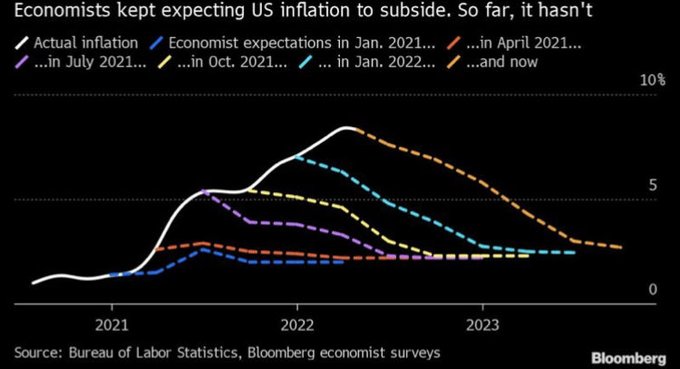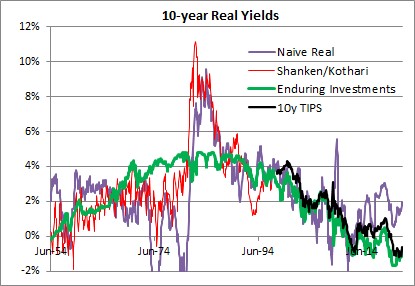Recently, Fed officials have discussed long-term equilibrium interest rates as a way of indicating to the market where interest rates might ultimately be heading.
It is not exactly a terrifying prospect. The Fed seems to collectively believe that the neutral short-term nominal interest rate is in the 2.50%-2.75% range; some fear that the Fed funds target right may have to be lifted modestly above this level.
This seems hard to believe, with inflation running with an 8% handle – such an overnight rate would equate to an annual 5-6% incineration of purchasing power. The only way this could be considered neutral is if one begs the question by asserting contrary to evidence that the long-run equilibrium inflation rate is around 2%-2.25%.
I have noted repeatedly over the last year or so why it is unlikely, in my opinion, that the current equilibrium for inflation is in the 2% range; I feel it is closer to 4%-5% in the medium-term. But if an observer has a model which has been ‘trained’ on data from the last thirty years, the model will assuredly tell you that any time inflation deviates from 2%, it comes back to 2%.
In fact, any model which did not produce that prediction would not have been considered a good model: it would have made predictions that, for 30 years, would have been noticeably incorrect from time to time. Ergo, all surviving models will view something like 2% as an attractive level for inflation, and we know the Fed continues to believe this. So, evidently, do many other economists.
I keep showing the following chart because I think it’s delicious. Take today’s level; take the level your model says is a self-enforcing equilibrium, and draw a straight line. That’s your forecast. You, too, can be a million-dollar Wall Street economist.

Faced with awful predictions from this cadre of models, one solution is to consider why they had bad predictions and attempt to develop models that would perform on data from the 1970s and 1980s.
From an institutional perspective, a more attractive solution is to blame model-exogenous events: “the model is fine; who could have foreseen that supply chain issues would have triggered such a large inflation?”
And so, we preserve the FOMC’s ability to continue making terrible forecasts.
Similarly, Minneapolis Fed President Neel Kashkari stated not too long ago that the Fed may have to:
“push real long-term rates into restrictive territory.”
This continues the Fed’s error of obsessing on the price of liquidity rather than its quantity, but that isn’t the point I am making here. Kashkari made a different error in an essay posted on the Minneapolis Fed website on May 6th. He claimed that the neutral long-term real interest rate is around 0.25%, conveniently where long-term real rates are now.
However, we can demonstrate that logic, reinforced by history, indicates that long-term real rates ought to be in the neighborhood of the economy’s long-term real growth rate potential.
I will use the classic economist’s expedient of a desert-island economy. Consider such an island with two coconut-milk producers and no inflation for mathematical convenience so that real and nominal quantities are the same.
These producers are able to expand production and profits by about 2% per year by deploying new machinery to extract the milk from the coconuts. Now, let’s suppose that one of the producers offers to sell his company to the other and to finance the purchase by lending money at 5%.
The proposal will fall on deaf ears since paying 5% to expand production and profits by 2% makes no sense. At that interest rate, either producer would rather be a banker. Conversely, suppose one producer offers to sell his company to the other and to finance the purchase at a 0% rate of interest – the buyer can pay off the loan over time with no interest charged. Now the buyer will jump at the chance because he can pay off the loan with the increased production and keep more money in the bargain. The leverage granted him by this loan is very attractive. In this circumstance, the only way the deal is struck is if the lender is not good at math.
Clearly, the lender could increase his wealth by 2% per year by producing coconut milk but is choosing instead to maintain his current level of wealth. Perhaps he likes playing golf more than cracking coconuts.
In this economy, a lender cannot charge more than the natural growth in production since a borrower will not intentionally reduce his real wealth by borrowing to buy an asset that returns less than the loan costs. And a lender will not intentionally reduce his real wealth by lending at a rate lower than he could expand his wealth by producing.
Thus, the natural real rate of interest will be in equilibrium at the natural real rate of economic growth. Lower real interest rates will induce leveraging of productive activities; higher real interest rates will result in deleveraging.
This isn’t only true of the coconut economy, although I would strongly caution that this isn’t exactly a trading model and only a natural tendency with a long history. The chart below shows (1) a naïve real 10-year yield created by taking the 10-year nominal Treasury yield and subtracting trailing 1-year inflation, in purple; (2) a real yield series derived from a research paper by Shanken & Kothari, in red; (3) the Enduring Investments real yield series, in green, and (4) 10y TIPS, in black.
The long-term averages for these four series are as follows:
- Naïve real: 2.34%
- Shanken/Kothari: 3.13%
- Enduring Investments: 2.34%
- 10y TIPS: 1.39%
- Shanken/Kothari thru 2007; 10y TIPS from 2007-present: 2.50%
It isn’t just a coincidence that calculating a long-term average of long-term real interest rates, no matter how you do it, ends up being about 2.3%-2.5%. That is also close to the long-term real growth rate of the economy. Using Commerce Department data, the compounded annual US growth rate from 1954-to 2021 was 2.95%.
It is generally conceded that the economy’s sustainable growth rate has fallen over the last 50 years, although some people place great stock (no pun intended) on the productivity enhancements which power the fantasies of tech sector investors. I believe that something like 2.25%-2.50% is the long-term growth rate that the US economy can sustain, although global demographic trends may be dampening that further.
This, in turn, implies that something like 2.00%-2.25% is where long-term real interest rates should be in equilibrium. Kashkari says:
“We do know that neutral rates have been falling in advanced economies around the world due to factors outside the influence of monetary policy, such as demographics, technology developments, and trade.”
Except that we don’t know anything of the sort since there is a strong argument against each of these totems.
Abbreviating those counterarguments are (a) aging demographics is a supply shock which should decrease output and raise prices with the singular counterargument of Japan also happening to be the country with the lowest growth rate in money in the last three decades; (b) productivity has been improving since the Middle Ages, and there is no evidence that it is improving noticeably faster today – and if it did, that would raise the expected real growth rate and the demand for money; and (c) while trade certainly was a following wind for the last quarter-century, every indication is that it is going to be the opposite sign for the next decade.
It is time to retire these shibboleths. Real interest rates have been kept artificially too low for far too long, inducing excessive financial leverage.
Eventually, they will return to equilibrium, but it will be a long and painful process.
